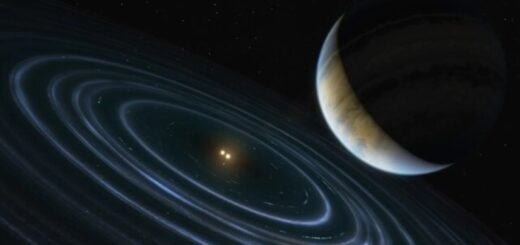Deep in the Heart of Our Galaxy, Einstein Proved Right Again

Scientists always seem to be finding new evidence of Albert Einstein “being right.” The latest example comes from astronomers using the European Southern Observatory’s Very Large Telescope (VLT) in Chile. Astronomers there have been studying the stars that orbit dangerously close to the supermassive black hole in the center of our galaxy to find that – you guessed it! – Einstein’s landmark theory of general relativity is holding strong, even at the doorstep of the most extreme gravitational field in our galaxy.
Supermassive Laboratories
Most galaxies are known to have supermassive black holes lurking in their cores, and our galaxy, the Milky Way, is no different. Located approximately 26,000 light-years from Earth, our black hole behemoth is called Sagittarius A* (aka Sgr A*), and it has a mass 4 million times that of our sun. Astrophysicists are hugely interested in black holes, as they’re the most compact, gravitationally dominant objects known in the universe and, therefore, an extreme test for relativity.
the center of the Milky Way
A peek at the center of our galaxy, courtesy of the ESO’s Very Large Telescope, with Sagittarius A*, our galactic black hole, and S2, a daredevil star that orbits relatively close to Sgr A*, highlighted.
ESO/MPE/S. GILLESSEN ET AL.
By tracking the motion of stars orbiting close to Sgr A*, a team of German and Czech astronomers have analyzed 20 years of observations made by the VLT and other telescopes using a new technique that pinpoints the positions of these stars. One of the stars, called S2, orbits Sgr A* every 16 years and zooms very close to the black hole – around four times the sun-Neptune distance. Because of its racetrack orbit deep inside the black hole’s gravitational well, S2 is treated as a natural relativity “probe” into this mysterious “strong gravity” environment.
“The galactic center really is the best laboratory to study the motion of stars in a relativistic environment,” said Ph.D. student Marzieh Parsa, who works at the University of Cologne in Germany, in a statement. “I was amazed how well we could apply the methods we developed with simulated stars to the high-precision data for the innermost high-velocity stars close to the supermassive black hole.” Parsa is lead author of the study published in The Astrophysical Journal.
Newton, Meet Einstein
By precisely measuring its motion around the black hole, the researchers could compare its orbit with predictions laid out by classical Newtonian dynamics. They found that the star’s actual orbit deviated from Newtonian predictions exactly as predicted by Einstein’s general relativity – although the effect was slight.
In a nutshell, Einsteinian gravity treats space and time as two of the same – four-dimensional “spacetime” where time is another dimension incorporated into the three dimensions of space – and matter influences the curvature of spacetime while the curvature of spacetime influences the motion of matter. For example: If you have a massive object, it will bend spacetime, like the famous example of the bowling ball suspended on a rubber sheet. If another object travels past the massive object, the curvature of spacetime will deflect its direction of motion – like a marble rolling past the bowling ball.
Classical Newtonian gravity assumes space and time are separate dimensions and does not include the effects of the curvature of spacetime. Therefore, general relativity will leave an imprint in the motion of all moving objects in the universe (creating a deviation in an object’s predicted Newtonian motion), and its slight effects become obvious in extremely strong gravitational environments, such as the immediate vicinity of Sgr A*. And only precision instruments like the VLT, which uses adaptive optics to remove the blurring effects of Earth’s atmosphere from astronomical observations, can detect this deviation.
In 2018, S2 will swoop to its closest point in its orbit around Sgr A*, and astronomers using the VLT are preparing a new instrument to get an even more precise view of the extreme environment surrounding the black hole. Called GRAVITY, the instrument is installed on the VLT Interferometer, and astronomers not only predict that it will get an even more precise gauge on Einstein’s general relativity, it might even detect deviations away from relativity, possibly hinting at new physics beyond relativity.



 Creators of mankind
Creators of mankind Description of “Tall white aliens”
Description of “Tall white aliens” Where they came from?
Where they came from? About hostile civilizations
About hostile civilizations The war for the Earth
The war for the Earth “Tall white aliens” about eternal life
“Tall white aliens” about eternal life Video: “Nordic aliens”
Video: “Nordic aliens” Aliens
Aliens Alien encounters
Alien encounters The aliens base
The aliens base UFO
UFO Technology UFO
Technology UFO Underground civilization
Underground civilization Ancient alien artifacts
Ancient alien artifacts Military and UFO
Military and UFO Mysteries and hypotheses
Mysteries and hypotheses Scientific facts
Scientific facts


















